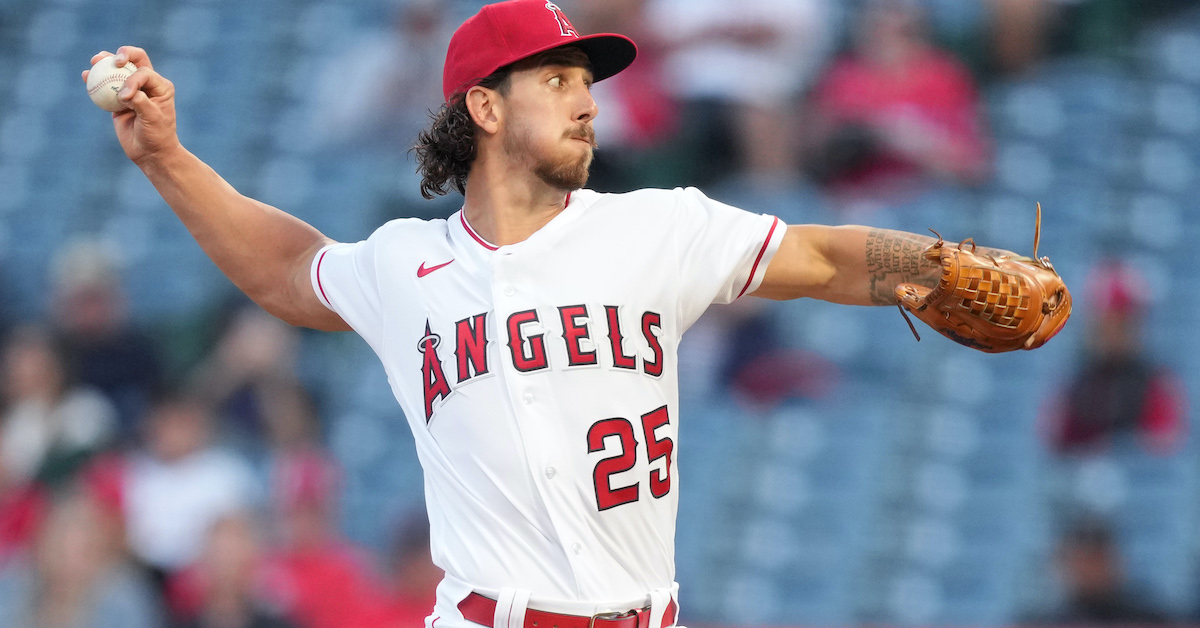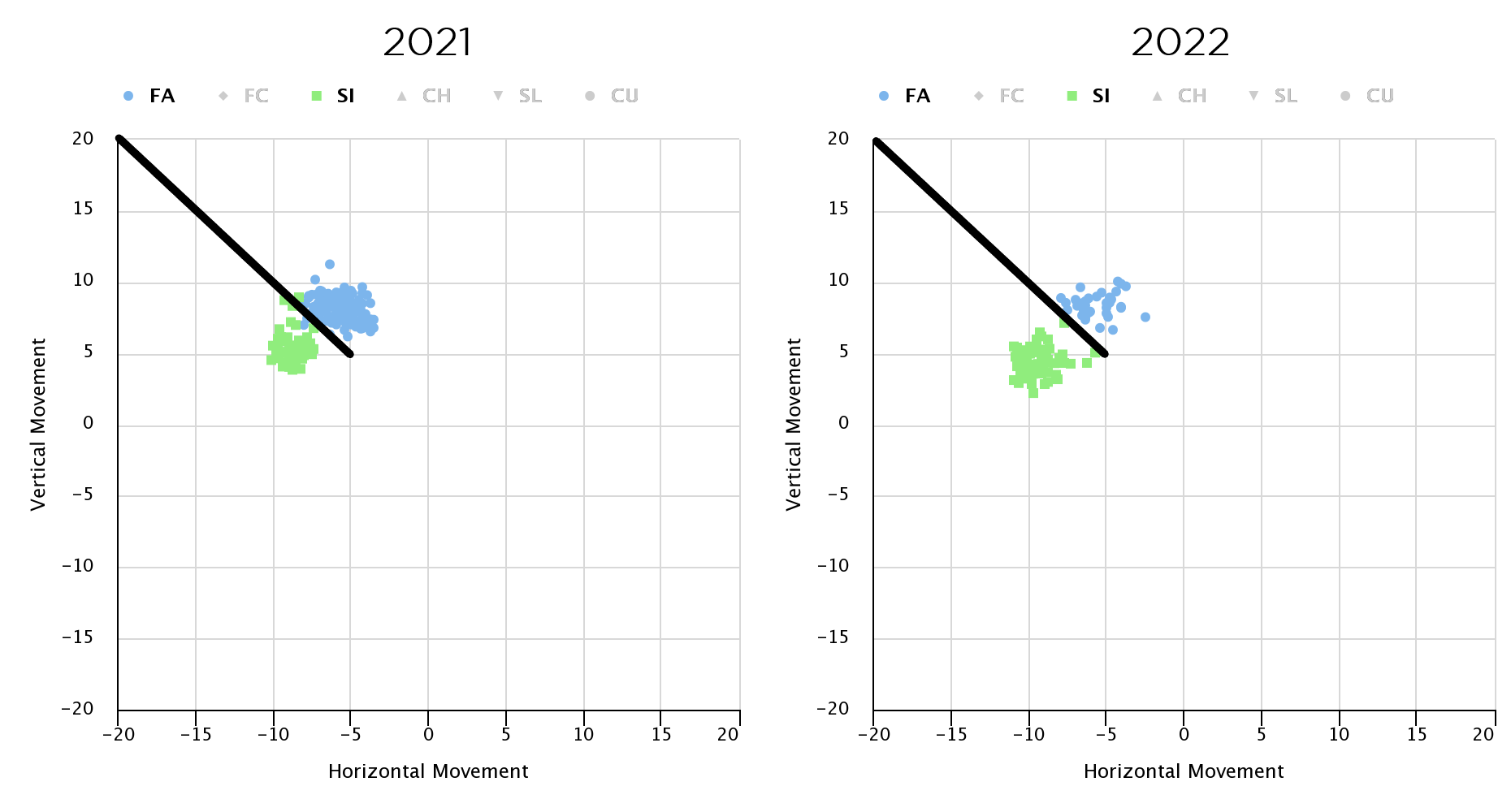Michael Lorenzen Throws the Kitchen Sink

When the Angels signed Michael Lorenzen this offseason, it was hard to say what to expect from him. A longtime member of the Reds’ bullpen for nearly his entire major league career, he entered his first time through free agency looking for an opportunity to start again; making that jump to the rotation came with all sorts of uncertainty. But after just two starts for his hometown team, the early returns have been promising.
The former 38th overall pick began his career as a member of the Reds’ rotation, making 21 starts during his rookie season back in 2015 but posting a 5.45 ERA and a 5.48 FIP and getting relegated to the bullpen by the end of the year. He enjoyed a bit of success in shorter outings the next year and wound up in that role for the rest of his time in Cincinnati. At various points during his time there, Lorenzen regularly expressed a desire to return to the rotation, but spring injuries often played a role in pushing him back to the bullpen. In 2016, it was a sprained ligament in his elbow; in ‘18, a shoulder injury. He was on track to join the rotation last spring until another shoulder injury derailed that plan again.
The fact that Lorenzen made it through spring training without an injury and actually made a start this season has to be seen as an accomplishment. Not only that, but his first outing against the Marlins was outstanding: two hits over six innings and a single run that scored on a Jesús Sánchez solo home run. He didn’t walk a batter and struck out seven. His next start was a much stiffer challenge against the Astros in Houston, where he lasted into the fourth inning but was done in by a lapse in command, issuing a walk and hit by pitch both with the bases loaded. He wound up allowing four runs on four hits and two walks in 3.1 innings of work, striking out two.
While the start in Houston didn’t go as well as his first, Lorenzen has shown some interesting changes to his pitch arsenal that could indicate some more success on the horizon. In his postgame comments after his Angels debut, he discussed his pitch profile:
“I worked really hard this offseason to get my stuff where it needs to be. It’s a lot more fun in the rotation. I’m able to use everything and set guys up certain ways for the next time through. It’s just more fun to do that instead of being limited. I have too many pitches to be limited in the bullpen, so I was just able to take advantage of my pitch profile.”
Even as a reliever, Lorenzen continued to use a full, six-pitch repertoire. He leaned on his four-seam fastball and cutter for the most part, but also sprinkled in a sinker, changeup, slider, and curveball.

The usage of that sinker has shot up dramatically this season; he’s tossed 60 across his first two starts, making it his most-thrown pitch. Meanwhile, the usage of his cutter has correspondingly fallen. What’s more interesting is that all but one of those sinkers were thrown to right-handed batters. That gives him a sinker/slider focus when holding the platoon advantage while leaning on his four-seamer, cutter, and changeup to deal with left-handed batters.
Lorenzen’s sinker has been a useful pitch for him in the past. Prior to this year, he generated a ground ball on 56.8% of the balls in play off of it and a .317 expected wOBA on contact. Opposing batters whiffed 16% of the time they offered at the pitch, a touch above the league-average rate for sinkers. In his two starts this year, he’s already generated nine whiffs with the pitch — a 25.7% rate — and a .202 xwOBAcon on 11 batted balls.
What’s more, the shape of Lorenzen’s sinker has looked much improved this year:
| Year | Velocity | Vertical Movement | Horizontal Movement | Spin Rate | Active Spin | Spin Differential |
|---|---|---|---|---|---|---|
| 2021 | 95.7 | 18.8 | 15.4 | 2244 | 92% | 45 mins |
| 2022 | 94.7 | 22.0 | 17.0 | 2267 | 85% | 60 mins |
| Difference | -1.0 | 3.2 | 1.6 | 23 | -7% | 15 mins |
As you can see, he’s added more than three inches of drop and an inch and a half of run to the pitch. The spin composition on the pitch has also changed with the physical characteristics; he’s now imparting more movement despite a less efficient spin profile with a higher spin differential. That tells us that there’s some seam-shifted wake effects taking place, giving the sinker more movement than we’d expect simply based on its measured spin profile. Here’s what it looked like in practice during his first start of the year:
Nearly every single whiff that Lorenzen has generated with the pitch has come when it’s located under the hands of a right-handed batter, like that example above. (At the end of the clip, you can clearly see Brian Anderson mouthing, “That’s fucked up.”) Lorenzen racked up five strikeouts with his sinker during his debut and added another in his start against the Astros. In addition, nearly two-thirds of the balls in play off his sinker have been put on the ground.
The additional vertical and horizontal movement certainly helps the pitch stand out on its own. But when taken into account with the rest of his repertoire, it’s clear the improvements have several knock on effects.

The new shape of his sinker moves it further away from the “line of normality” and further differentiates it from his four-seam fastball. It also helps him mirror the shape of his changeup more closely, with a velocity differential of eight miles per hour.
Lorenzen’s slider, meanwhile, has been his most effective pitch at generating swings and misses. He’s earned a 33.8% whiff rate with the pitch during his career, and that’s jumped up to 46.4% over the last three years. That breaking ball has also undergone some changes, though they were implemented last year.
| Year | Velocity | Vertical Movement | Horizontal Movement | Spin Rate | Active Spin | Spin Differential |
|---|---|---|---|---|---|---|
| 2020 | 85.0 | 39.4 | 8.7 | 2508 | 32% | 60 mins |
| 2022 | 83.5 | 39.9 | 12.4 | 2495 | 37% | 60 mins |
| Difference | -1.5 | 0.5 | 3.7 | -13 | 5% | 0 mins |
Over the last two years, his slider has gained almost four inches of horizontal movement. That puts it in “sweeper” territory, though his was developed independently of the Dodgers’ pitching factory. Here’s what it looks like now:
When located on the outside edge of the zone, that pitch is deadly. It also gives Lorenzen two pitches that break away from each other, shifting the batter’s focus horizontally across the zone.
Way back in 2016, Lorenzen threw his slider 38.9% of the time; the highest it’s been since then is 17.4% in ‘20. Through two starts this year, he’s throwing it 18.5% of the time, and it’s earned a whiff a third of the time batters swing at it. It certainly seems like he has optimized his pitch mix to feature his two new toys much more often. Both his bowling ball sinker and sweeping slider should be extremely effective against right-handed batters. He’ll need to lean on the rest of his repertoire to hold left-handed batters at bay.
The first two starts of Lorenzen’s effort to rejoin the rotation have been filled with promise. He had a bit of a hiccup against Houston, but the underlying metrics and improved individual pitch characteristics are definitely positive signs. Even if this experiment as a starter doesn’t end up working out for whatever reason, the changes he’s made to his repertoire bode well for his ability to continue to excel in a relief role, particularly as a right-handed specialist. And if he does stick in the rotation for the rest of the season, that would be a nice payoff for the pitching-starved Angels.
Jake Mailhot is a contributor to FanGraphs. A long-suffering Mariners fan, he also writes about them for Lookout Landing. Follow him on BlueSky @jakemailhot.

Watched him pitched against the Astros and he was basically falling off the mound after his delivery. Don’t know how he’s able to keep it around the strike zone